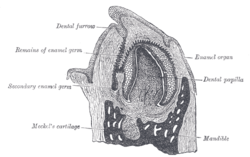This article needs additional citations for verification. (October 2018) |
| Dental papilla | |
|---|---|
 Vertical section of the mandible of an early human fetus. × 25. (Dental papilla labeled at center right.) | |
 Histologic slide showing a tooth bud. A: enamel organ B: dental papilla C: dental follicle | |
| Details | |
| Identifiers | |
| Latin | papilla dentis |
| MeSH | D003771 |
| TA98 | A05.1.03.054 |
| TE | papilla_by_E4.0.3.3.1.0.12 E4.0.3.3.1.0.12 |
| FMA | 57662 |
| Anatomical terminology | |
In embryology and prenatal development, the dental papilla is a condensation of ectomesenchymal cells called odontoblasts, seen in histologic sections of a developing tooth. It lies below a cellular aggregation known as the enamel organ. The dental papilla appears after 8–10 weeks of intra uteral life. The dental papilla gives rise to the dentin and pulp of a tooth.
The enamel organ, dental papilla, and dental follicle together forms one unit, called the tooth germ. This is of importance because all the tissues of a tooth and its supporting structures form from these distinct cellular aggregations. Similar to dental follicle, the dental papilla has a very rich blood supply and provides nutrition to the enamel organ.[1]
- ^ Creanor, Stephen, ed. (February 2016). Essential clinical oral biology. Chichester, West Sussex: Wiley. ISBN 9781118939666. OCLC 917888653.